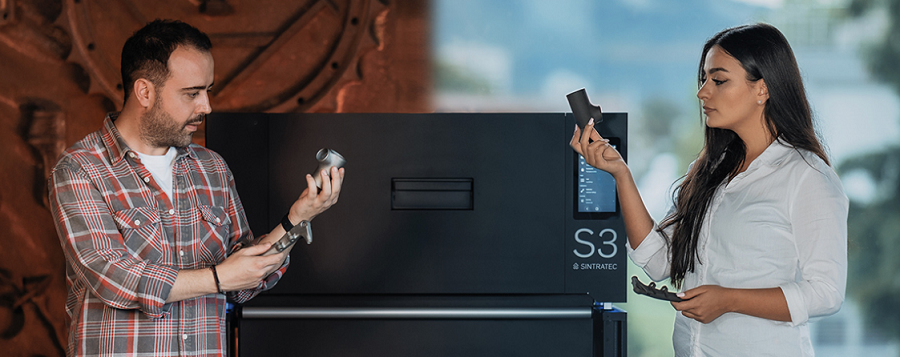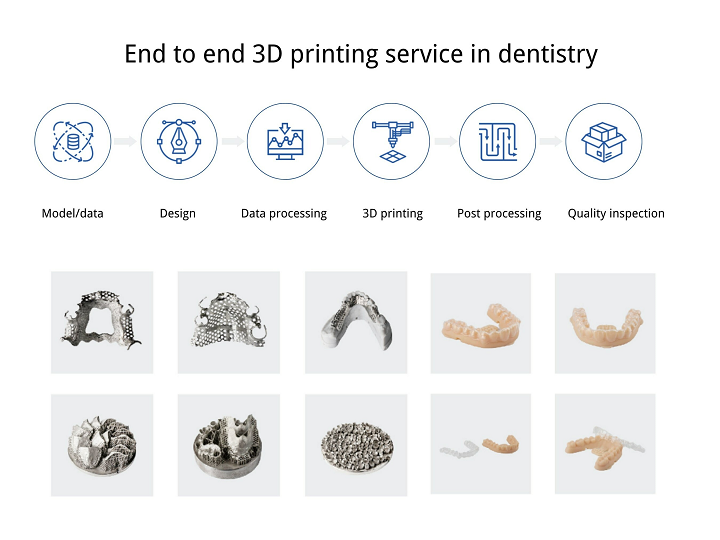We’re discussing Sintratec’s All-Material Platform first in today’s 3D Printing News Briefs, and then moving on to an NSF Career Award for a University of Pittsburgh research and a Phase I STTR contract for Phase3D and 1000Kelvin. On to business, as DuPont will acquire Spectrum Plastics Group and Chinese dental 3D printing company Chamlion raised $34 million in funding. Finally, actor Nicolas Cage used 3D printed dentures to turn into Dracula for a recent film.
Sintratec All-Material Platform (AMP) for SLS 3D Printing
Sintratec has a new, patented selective laser sintering (SLS) solution: the All-Material Platform, or AMP, which separates the Fusion Module, or 3D printer, from the movable Build Module, or powder container. Because of this modular platform, users can process both metals and polymers on the same system, without worrying about time-consuming cleaning or cross-contamination. All AMP modules are cross-compatible, and it’s easy to scale up from one system and expand to swarm manufacturing. The Sintratec S2 and Sintratec S3 Fusion Modules include high-tech fiber laser and optics, and the AMP Build Modules—designed to carry all Sintratec materials through their cylindrical build volumes—are the new Sintratec MCU-220 and the Sintratec MCU-160. Finally, the Sintratec MHS is the AMP Material Handling Module, and allows users to see the object they’re depowdering, and easily collect, sieve, and recycle any unused powder.
“The AMP’s novel modular approach allows for all current and future Sintratec modules to be compatible and interchangeable with one another. This means that you can seamlessly scale your manufacturing setup from one to ten or one hundred systems and tailor it perfectly to your application.”
NSF Award Given to Pittsburgh Professor for PAM Research
Xiayun Zhao, an assistant professor of mechanical engineering and materials science at the University of Pittsburgh’s Swanson School of Engineering, received a prestigious Faculty Early Career Development (CAREER) award from the National Science Foundation (NSF) for her research to improve photopolymer additive manufacturing (PAM). The technology cures photosensitive materials to enable 3D printed components with high resolution and precision, but overcuring is still an issue, and can harm the structural integrity of parts. Zhao will use the $657,610, five-year award to develop a smart digital light processing (DLP) method that takes advantage of photoinhibition, induced by a second wavelength, to control curing parts, thus allowing the manipulation of “cure and curb exposures of the PAM processing” to achieve printed parts with improved functional integrity and geometrical fidelity. If her work is successful, it could have a major impact on several applications, like soft robots, metamaterials, and electrodes, that need precision manufacturing for parts with strengthened performance and complex shapes.
“Usually, we use a single-wavelength light to cure the polymer, but this new method will use two wavelengths—one to cure the material, and one to prevent the material from over-expanding into the surrounding area. This way, we can increase both the accuracy and the resolution in three dimensions, and we can not only improve printing speed but also optimize both the lateral and vertical profiles of printed material,” Zhao explained.
“Using a single wavelength to cure polymers while printing is already complex. Adding a second escalates that complexity, but we can use machine learning to enhance our accuracy and accelerate our progress. Conventional machine learning calculations take time and aren’t fast enough for real-time control yet, but the digital twin we’ll develop as part of this project based on the state-of-the-art physics-informed neural networks will help us in that endeavor.”
USAF Awards Phase I STTR Contract to Phase3D & 1000Kelvin

Through the collaboration of Phase3D and 1000Kelvin, laser scan path optimization will correct defects during the build using in-situ data collected by Project Fringe.
Software startup Phase3D, together with 1000Kelvin, are partnering up for real-time AM anomaly detection, and were awarded an AFWERX STTR Phase I grant from the US Air Force to show the feasibility of closed-loop optimization for laser pathing, based on in-situ inspection from Phase3D’s Project Fringe. This patent-pending quality monitoring system detects and measures anomalies in powder bed AM methods through the use of structured light, and the two startups hope to advance the project by combining their solutions. 1000Kelvin will add AMAIZE, its AI-based scan path analyzer and optimizer, to Project Fringe, hopefully by combining Phase3D’s in-situ inspection with 1000Kelvin’s corrective algorithms, the two can develop a future joint product that can inspect every layer of a part during printing and immediately correct for defects, which would reduce waste and increase production efficiency.
In order to prove that 3D printed parts can definitely be used in critical applications, such as energy production, medical implants, and aviation, the AM industry desperately needs real-time part certification and qualification, using available, objective data to fix and save parts before they come off the print bed already defective. That’s why this collaboration between Phase3D and 1000Kelvin is so beneficial, and this research, now funded by AFWERX, will be serving three specific customer segments, including research laboratories, the aerospace industry, and industrial metal 3D printing OEMs. But the main goal behind the joint project is to benefit in-house AM production facilities, and AM service bureaus, focused on aerospace parts.
DuPont Acquires Spectrum Plastics Group for $1.75 Billion
Global innovation leader DuPont has entered into an agreement to acquire medical device manufacturer Spectrum Plastics Group from AEA Investors for $1.75 billion. A leader in advanced manufacturing of specialty medical devices and components, Spectrum employs over 2,200 people and has consistently delivered high single-digit growth rates for years. It serves 22 of the top 26 medical device OEMs, with a strategic focus on the main fast-growing therapeutic areas like cardiovascular, structural heart, surgical robotics, and electrophysiology. The company has a customer-centric orientation and has been smart with its investments in commercial and engineering organizations; these factors, coupled with its manufacturing expertise and strong financial performance, align Spectrum with DuPont’s objective to deliver specialized solutions and materials into top end markets with “long-term secular growth trends,” like healthcare and pharma processing. After the acquisition, approximately 10% of DuPont’s consolidate revenue will come from healthcare, and the transaction is expected to close by the end of Q3 2023.
“We have been focused on Spectrum for a long time and our team is extremely excited for this opportunity. Spectrum is a compelling strategic complement to our existing healthcare portfolio, which already includes businesses with best-in-class innovation, deep customer relationships and with strong growth and profitability,” stated Ed Breen, CEO and Executive Chairman of DuPont. “With this combination, we’ll be able to offer customers additional innovation and manufacturing capabilities with a broader and more integrated solution set.”
Chamlion Closes Series B Fundraising Round with 236 Million Yuan
Based in China, with established branches in Vietnam, the United States, France, and Turkey, digital dentistry firm Chamlion has completed a Series B funding round, and raised 236 million yuan ($34 million). The round was led by 3H Health Investment, followed by Vertex Ventures China and existing shareholder Zhencheng Capital, and Taihe Capital served as financial advisor. The company focuses on digitalizing the full dentistry process, and provides one-stop digital dental 3D printing solutions, applying the hardware as a service (HaaS) model. Chamlion built a large-scale distributed dental manufacturing cloud factory that connects the data, design, and manufacturing of dental processing, and uses both DLP resin technology—to replace manual plaster models—and metal 3D printing, which replaces manual casting. With its cloud software, 3D printers, materials, and 3D printing services for dentures and semi-finished crowns, Joris Peels called the company a “superapp for 3D printing dental.” Chamlion will use this latest round of funding to further expand its overseas and domestic business, including promoting and upgrading its current product line, to consolidate its top position in the lucrative digital dentistry field.
“The dental industry is facing opportunistic transformation, and the global dental supply chain is developing in the direction of digitalization, intelligence and intensification. Digging deep into vertical scenarios and providing complete software and hardware solutions is the cornerstone of dental supply chain integration. Chamlion focuses on dental processing scenarios and is committed to providing digital and intelligent overall solutions for the dental industry. It adopts the cloud factory model to empower the global dental processing market and improve the overall level of the industry,” 3H Health Investment said.
“3H Health is very pleased to have the opportunity to become the lead investor of this round fundraising, and firmly supports Chamlion to deeply participate in the structural opportunity of the integration of the global dental supply chain with innovative solutions of “Intelligent Manufacturing in China“. With the efforts of the company’s professional team, we are optimistic that Chamlion will become a leader in supply chain integration and digital processing in the global dental industry, and 3H Health looks forward to creating a new chapter in the future dental industry with Chamlion.”
Nicolas Cages Wore 3D Printed Dentures in Renfield Movie
Speaking of dental 3D printing, Oscar-winning actor Nicolas Cage shaved down his teeth, and sported a pair of 3D printed dentures, to create sharp fangs for his recent role as Dracula in Renfield, which hit movie theatres last month. Cage, 59, played the role as a combination of funny and scary, and wanted to make sure that he was able to emote, and annunciate, while wearing the dentures, so this would come across well on-screen. So it was important that the dentures were perfectly fitted, with thin veneers. 3D printing gave the team freedom to quickly create a variety of different denture designs, and also enabled them to easily produce multiple sets in case a pair broke.
“This was the first film that I know of where we used 3D printing to do all the dentures,” said makeup artist Christien Tinsely, who was nominated for an Oscar for his makeup work on 2004’s The Passion of the Christ. “We jumped in headfirst with 3D printing. We would scan Nic’s teeth and digitally sculpt them.”
3D printing has been used in the film industry many times, but this is definitely the first movie I’ve heard of that features an actor wearing 3D printed dentures. I can’t wait to see this one!
Subscribe to Our Email Newsletter
Stay up-to-date on all the latest news from the 3D printing industry and receive information and offers from third party vendors.
You May Also Like
Further Understanding of 3D Printing Design at ADDITIV Design World
ADDITIV is back once again! This time, the virtual platform for additive manufacturing will be holding the first-ever edition of ADDITIV Design World on May 23rd from 9:00 AM –...
3D Printer Maker EVO-tech Reborn as NEVO3D — Once More With Feeling
EVO-tech was a 3D printing service and original equipment manufacturer established in 2013 and based in Schörfling am Attersee, Austria. The company produced high-quality material extrusion systems featuring linear bearings,...
3D Systems Brings 3D Printed PEEK Cranial Implant to the U.S. with FDA Clearance
For more than 10 years, 3D Systems (NYSE:DDD) has worked hand-in-hand with surgeons to plan over 150,000 patient-specific cases, and develop more than two million instruments and implants from its...
CDFAM Returns to Berlin for Second Annual Symposium
The second CDFAM Computational Design Symposium is scheduled for May 7-8, 2024, in Berlin, and will convene leading experts in computational design across all scales. Building upon the first event...




































